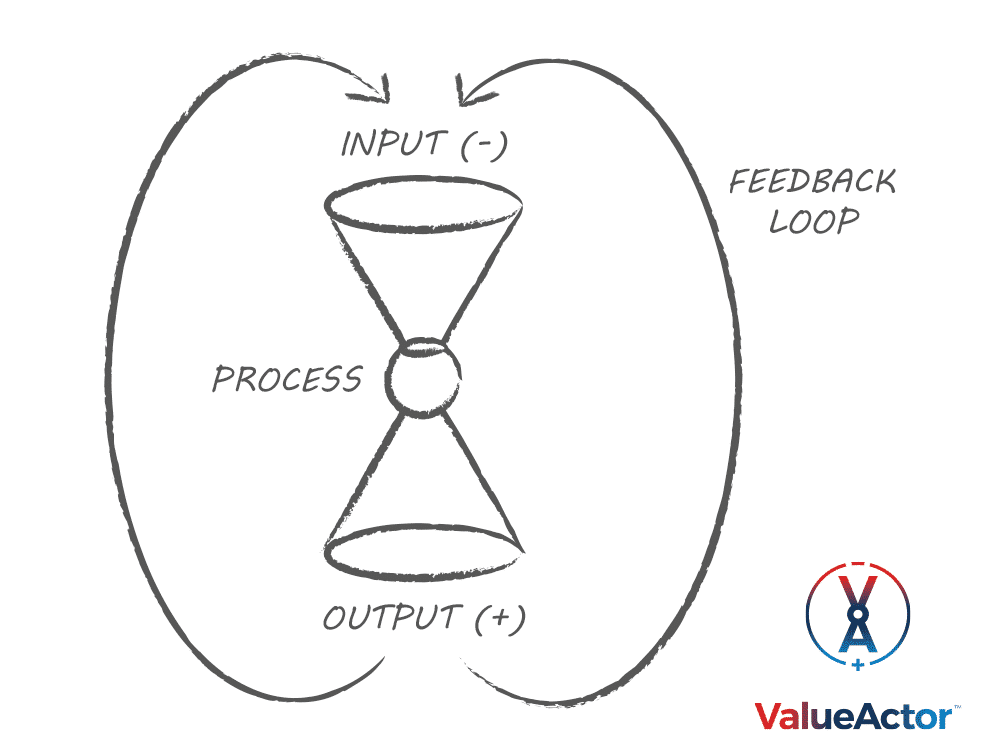In hindsight, our mission to provide an all-round framework to achieve resilient growth throughout the business cycles originated from a meeting in 2012. We were invited to bring a local radio station into the 21st century by incorporating social and digital technology. While exchanging ideas, a concept started taking shape, introducing the Value Actor (called initially a value hub)—a transformative agent in the modern, interconnected ecosystem of business and society.
Gone are the days when an organization or individual could operate as a passive cog in the machine, solely consumed with their interests. In our intricately woven world, the Value Actor emerges as a proactive contributor, intimately involved in the co-creation, exchange, and fulfillment of value across various stakeholders.
Armed with a unique blend of empathy, adaptability, and authenticity, a Value Actor moves beyond traditional transactional roles to create a resonating impact that sustains the business and the community. Guided by trust, continuous improvement, and sustainability principles, the Value Actor redefines value and how it should be created, communicated, and delivered.
Let’s dive into the key characteristics that set the Value Actor apart and discover how embracing this role could be your strategic advantage in a rapidly evolving landscape:

Definition of a Value Actor
A Value Actor can be defined as an individual, organization, or any entity that actively participates in a value-driven ecosystem, engaging in interactions to create, exchange, and fulfill value with other stakeholders. A Value Actor takes on the role of a proactive participant, focusing on generating positive outcomes and meaningful exchanges to address the needs and aspirations of his counterparts.
Key characteristics of a Value Actor are:
Value Creation: A Value Actor is driven by creating value for others. It seeks to offer products, services, or experiences that contribute positively to the lives of its customers, partners, or the broader community.
Empathy and Understanding: Understanding the needs and desires of other stakeholders is vital for a Value Actor. It empathizes with their perspectives and seeks solutions that resonate with their expectations.
Storytelling and Communication: Leveraging the power of storytelling, a Value Actor communicates its vision, mission, and the positive impact it aims to make, effectively conveying its value proposition to its audience.
Adaptability and Agility: Just like an actor adapting to different roles, a Value Actor remains flexible and adaptable, responding to changing market dynamics and the evolving needs of its stakeholders.
Authenticity and Trust: A successful actor portrays their character authentically, and similarly, a Value Actor operates with integrity, reliability, and transparency, building trust and credibility in his interactions.
Continuous Improvement: A Value Actor is committed to constant learning and improvement, seeking ways to enhance its offerings and strategies to deliver even greater value.
Collaboration and Co-creation: Recognizing the importance of cooperation, a Value Actor embraces co-creation, working with others to develop innovative solutions and enhance value exchange.
Impact and Sustainability: A Value Actor is mindful of the broader impact of its actions, striving to create sustainable value that positively influences its stakeholders and the ecosystem it operates within.
In summary, a Value Actor embodies the essence of value creation and purposeful action, contributing positively to the interconnected web of value exchanges within a dynamic ecosystem.
The Birth of the Value Actor
To understand the origin of RoundMap’s first principle, let’s go back to the case of the radio station. Like in business, a radio station must create value to attract, delight, and bind an audience. Ideally, the value appeals to an identifiable group of listeners, allowing the station manager to capture value from advertisers.
We argued that the station would benefit most from the interactive media channels if they used it as an additional source of information (to be processed to fit the dynamics of the outgoing channels) while capturing online reactions from the audience and bringing those back in the radio shows.
To explain the concept, we draw a simple image on the whiteboard. An image that would become fundamental to our way of thinking:

This quick sketch in 2012 of how value is sourced (input), created (process), and delivered (output), would soon determine our way of thinking about the meaning of value creation and how each of us participates in its dynamics.
By perceiving every human system as an active participant in the value-creation process, indeed, as a Value Actor, we could explore the idea of interconnectedness and how various entities, be they individuals, businesses, or even natural systems, can contribute value to one another through interactions. This perspective has significant implications in various fields, from business and economics to ecology and social dynamics.
And by perceiving the two value states, either a surplus (+) or a deficit (-), we began to see how Value Actors could be drawn toward each other (image to the right).
Following the Depletion of a Value Deficit
Two Value Actors can be attracted when one has a surplus of some value (+) and another has a deficit (need) of that value (-).
However, the two must be nearby because magnetic forces are weak. This requires them to know each other’s value state. This can be achieved through signaling (advertising, newsletter subscription, online inquiry, etc.).
When the two Value Actors get close enough, the value can flow from one to the other until the value deficit is depleted, i.e., the need is fulfilled.
Usually, this is the moment to depart. But suppose the seller continues to engage with the buyer, proclaiming future value or the meaning attached to the brand. In that case, the buyer may remain in the immediate vicinity, which hands us the potential to reduce customer churn.

Beyond Boundaries: The Role of Value Actors in Shared Value Networks
In today’s interconnected economy, the concept of a Value Actor extends beyond traditional organizational boundaries. While companies have historically focused on creating value for customers within their own operations, the emergence of Shared Value Networks (SVNs) emphasizes the importance of collaborative value creation across a broader ecosystem.
A Value Actor is any entity—be it an individual, organization, or group—that contributes to the creation, exchange, and enhancement of value within a network. In the context of SVNs, this role involves not only delivering value to direct customers but also engaging in network orchestration to foster partnerships that amplify positive impacts and mitigate negative effects.
Network orchestration refers to the strategic coordination of various stakeholders to achieve collective goals. By orchestrating a network of partners, Value Actors can enhance their impact through collaborative efforts, leading to more significant and sustainable outcomes. This approach aligns with the principles of creating shared value, where businesses generate economic value in a way that also produces value for society by addressing its challenges.
For instance, a company might collaborate with suppliers, customers, and even competitors to develop sustainable practices that benefit the entire industry. Such collaborations can lead to innovations that not only improve the company’s offerings but also contribute to societal well-being. By engaging in SVNs, Value Actors can amplify their positive impact and work collectively to mitigate any adverse effects of their operations.
In summary, embracing the role of a Value Actor within Shared Value Networks involves transcending traditional business boundaries to engage in network orchestration. This strategic collaboration amplifies positive impacts and mitigates negative effects, leading to more sustainable and inclusive value creation.
Continue Reading:

Mapping the Future: We’re Writing the Book on RoundMap®
At RoundMap®, we believe the future of business lies in wholeness, not fragmentation. For too long, organizations have been shaped by linear thinking, short-term gains,

More Than Crumbs: The Case for True Value Creation
For decades, shareholder primacy has dictated corporate decision-making, driving businesses to prioritize short-term profits and disproportionate returns to shareholders over long-term sustainability and stakeholder value.

Beyond Extraction: Why Regenerative Business is the Only Way Forward
The RoundMap’s Regenerative Business Framework proposes a dual-cycle approach to business: one focused on value creation and another on impact. However, reality presents us with

RoundMap Regenerative Business Framework: Empowering the Present while Building the Future
Executive Summary The Regenerative Business Framework addresses the critical need for businesses to move beyond mere profitability toward regenerative practices that drive long-term growth and

The RoundMap Flywheel: A Shift Toward Sustainable Ecosystem Resilience
What if impact creation was as strategic and intentional as value creation? What if every dollar earned didn’t just fuel a business’s bottom line but

From Striving to Thriving: How Amazon is a Strive-Driven Giant Failing to Thrive
Amazon has become synonymous with business success, often hailed as a master of efficiency, customer obsession, and innovation. At the heart of its growth strategy

Impact Strategies to Amplify Value and Mitigate Harm Across Stakeholders
What if doing the right thing wasn’t just a moral choice but a strategic one? What if amplifying your organization’s positive impact while mitigating harm

From Extraction to Contribution: Thriving Together with Shared Success
The Flywheel of Shared Success is designed to demonstrate that staying within the boundaries of responsible growth doesn’t mean limiting our ambitions—it means channeling them

The Twin Engines of Progress: Returns on Value and Impact
At the heart of the Flywheel of Shared Success lies the powerful interplay between Value Returns and Impact Returns, both of which operate on the

From Hopping for Cash to Building Bridges: Why Self-Interest Alone Can’t Sustain Shared Prosperity
What we’re proposing with the Flywheel of Shared Success is nothing short of a call to confront and correct our deeply flawed execution of Adam

The Strive & Thrive Cycle: Distinquishing Between Value and Impact
Distinguishing between value creation and deployment (Strive-phase) and impact creation and deployment (Thrive-phase) is critical to clarifying their roles within the Strive & Thrive Cycle. Here’s

From Striving to Thriving: How Decathlon is Shaping a Sustainable Future in Sports Retail
In the ever-evolving world of sports retail, the line between short-term success and long-term impact is a delicate balancing act. For companies like Decathlon, the




